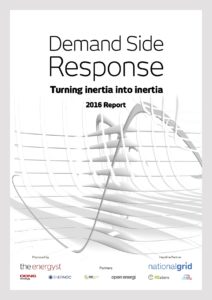 A survey of 200 end-users finds most businesses are interested in earning revenue from demand-side response. However many continue to fear disruption to operations and believe that their business processes are incompatible with DSR, hamstringing National Grid’s drive to scale the market.
A survey of 200 end-users finds most businesses are interested in earning revenue from demand-side response. However many continue to fear disruption to operations and believe that their business processes are incompatible with DSR, hamstringing National Grid’s drive to scale the market.
Almost nine in ten businesses would help National Grid balance the power system if it did not adversely affect their operations, according to a new report.
However, concerns around disruption and unsuitable equipment and processes remain key inhibitors to demand-side response (DSR) uptake.
Energyst Media’s 2016 Demand-Side Response report polled more than 200 end users from public and private sector organisations to gauge their views on DSR.
Key findings: Non-participants
- Around three quarters (73%) of those polled do not currently participate in DSR. More than half (57%) have some form of onsite generation, which suggests significant potential for provision. Yet half (51%) said they had not been contacted by an aggregator or supplier about DSR.
- 87% of non-providers said they would be interested in earning revenue from DSR if it did not affect their operation.
- However, fear of disruption (cited by 37%) and a belief that their equipment and processes are not suitable (39%), were the main reasons that respondents had not considered DSR participation.
- Three in ten (28%) said they did not understand the market well enough to make a decision while roughly a quarter (24%) think return on investment is insufficient. A similar number expressed concerns around ceding control to third parties (23%).
Key findings: DSR providers
- Around a quarter (27%) of those polled currently provide demand-side response services, the majority (76%) through on-site generation. Six in ten (59%), mainly industrial and commercial (I&C) companies, also switch off or turn down consumption. However, only 14% provide purely turndown DSR.
- More than half (55%) of market participants polled use diesel back-up generators to provide demand-side response services.
- The main motivation for participation is to earn income from assets (85%) and avoid peak network charges (40%).
- Four in ten (42%) use up to 10% of site consumption to provide DSR while 21% said they use 10-25% of site consumption. Around 10%, mainly I&C firms, said up to half of site consumption is utilised for DSR.
- Eight in ten (79%) DSR providers contract their flexibility through an aggregator and 86% are satisfied with the outcome.
Batteries and investment: all respondents
All survey participants were asked how they use, or would use, DSR revenues. Around half (47%) of respondents would offset their energy costs with proceeds, or already do so. Around a third (31%) would invest, or are investing, in energy efficiency and around 10% would invest, or are investing, DSR revenues in new equipment.
All survey participants were also asked about energy storage, such as batteries, with 52% stating that they had invested in storage, or were considering investment.
The report, sponsored by National Grid, Dong Energy, Enernoc, Kiwi Power, Open Energi, Restore and SmartestEnergy, is available as a free download at: theenergyst.com/dsr
As well as survey data, the report contains views on key market and customer barriers from end users, aggregators, consultants and suppliers, plus an outline from National Grid of how it plans to implement the next phase of its Power Responsive campaign.
It also presents views on the challenges and opportunities presented by the capacity market as well as new National Grid programmes such as Enhanced Frequency Response (EFR) and Demand Turn-Up (DTU).
Download the report here: theenergyst.com/dsr
Related stories:
More than half of I&C firms mulling energy storage investment
Grid buys 201MW of enhanced frequency response
Battery storage: positive outlook?
Demand-side response: Give us your views
National Grid must provide a plan for battery market, says SmartestEnergy
Can National Grid hit its 2020 DSR target?
Limejump boss: Big six will have to acquire aggregators or lose relevence
National Grid buys 3.6GW of back-up power to cover winter
Three policy tweaks that could enable 10GW of battery storage
Decc, Ofgem and National Grid must make battery storage stack-up
Ofgem: Energy flexibility will become more valuable than energy efficiency
National Grid boss: future of energy is demand not supply
National Grid says impact of solar requires greater system flexibility
National Grid signs 20MW demand-side response contract with battery storage operator
National Grid says UK will miss 2020 targets, predicts big battery future
Major changes to capacity market proposed
Hot technology: energy storage via heat battery
Western Power Distribution ramps up demand-response trials, calls for participants
Smart grids ‘require local control and businesses must play or pay’
National Grid must simplify demand response to scale UK market
Energy Technologies Institute: Let private firms run smartgrid trials
Flexitricity blasts transitional capacity market as Npower plots supermarket sweep
Follow us at @EnergystMedia. For regular bulletins, sign up for the free newsletter.



